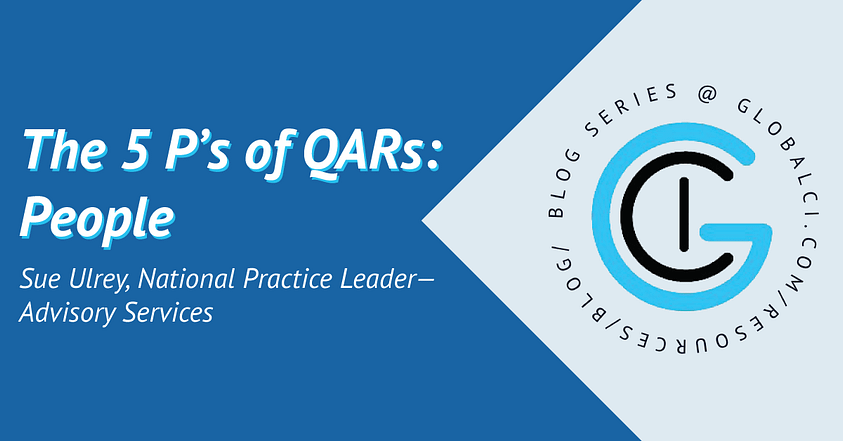Perhaps one of the most obvious and crucial aspects of QARs is people. Most internal audit activity either succeeds or fails based on how you utilize the talent and competencies within your team and recognize the need to seek third party assistance. Being able to evaluate the skills and competencies within your team on a collective and individual level is pertinent to success.
While figuring out how to manage and navigate your team’s success during internal audit activity might be difficult, identifying common pitfalls ensures you are on the right path to success. When internal audit activity fails within organizations, three aspects are either missing or not being addressed: talent management and strategy, proper training, and gaps in talent.
- Lack of Talent Management and Strategy Plan
Over 50% of QARs do not have a strategic plan at the onset of the assessment review. Not having this plan in place is like building a home without blueprints. Without it, the whole foundation with fall through. This lack of a strategic plan is evident in the other missing facets of the assessment process: 25% of QARs do not have talent management plans that address the full cycle of recruiting, retention, and replacement. While it is an investment to have these plans, it is critical to success.
If you are struggling to gauge what you need to address in your talent management and strategy plans, think about the skills that are necessary to meeting stakeholders’ expectations.
Some typical skills stakeholders expect are:
- Analytical and critical thinking skills
- Communication skills
- IT knowledge and expertise
- Business acumen
- Data analysis and data mining
Key questions and reflections on these skills can help navigate your strategy and talent management plan. Are you addressing these skills in your plan? Are there other skills key stakeholders expect? How do these skills change over time? Who on your team has these skills? How can people on your team who excel at certain skills help those who may struggle in other avenues? How are you assessing and evaluating who has which skills?
- Insufficient Training
According to the IIA’s standards, organizations must undertake work by those who have the knowledge, skills, and competencies required. Thus, professional qualifications and ongoing learning are essential. However, I have noticed many organizations failing to provide adequate training, if any training at all.
Some examples of inadequate training include:
- No training
- Minimal training
- “Free” training only
- Limits on hours of training available
- Misaligned training with development path
When organizations fail to provide training, it is often due to budgetary constraints. And when some organizations do provide training, it is often minimal, meaning less than 20 hours of training. Most benchmarks suggest 40 to 60 hours of training (or more for IT). Once employees have reached their benchmark of training hours, some organizations prohibit employees from completing more hours of training, often capping training hours at 40 hours. Within these hours of training that are completed, they often do not align with upcoming projects.
All of these issues in insufficient training lead to major gaps that impact the quality and competency of the internal audit activity, hindering success for individual employees and your organization as a whole. Why stop your employees from receiving more training and learning, particularly training which aligns with their role and development path? Ensuring your employees receive sufficient training can make them feel competent and happy in their expectations, abilities, and roles, all of which can lead to better retention and success rates.
- Gaps in Talent
I often see work being delegated to staff based on what needs to be done, rather than what is within staff’s abilities and scope. Solely focusing on what needs to be done versus staff ability can have a negative impact on the depth and breadth of a particular audit, ultimately leading to decreased value in your organization. It is okay to bring in outside resources and actually better for your organization in the long run. Perhaps some Chief Audit Executives feel they are failing by bringing in outside resources, but this is not the case. Recognizing gaps in talent is a strength, as it shows your ability to see what your organization needs to grow and succeed. This will also release the burden on staff that are completing tasks that are outside their scope and give them time to focus on what they do best.
About 33.3% of QARs reflect third party usage. Using outside sources is a good way to utilize talent that is competent in their field of work and expertise (ex. IT, cyber security, or regulatory compliance). Because of their expertise, certifications, and trainings, third parties can share their knowledge with the core team and also receive support from internal teams. Overall, this can improve the experience and exposure to new areas of expertise for everyone involved. Use of third parties can be the key to success and growth for your organization. Don’t be afraid to ask for help when your organization needs it.
Next Week’s Topic: Processes

The 5 P’s of QARs: Infographic (plain text)
25% of QARs don’t address recruiting, retention, and replacement. Make sure to include a talent strategy plan, including skills that meet key stakeholders’ expectations.
Most benchmarks suggest 40-60 hours of training, or more. Provide training that meets benchmarks and development paths for individuals and future projects.
~33% of QARs reflect organizations using third parties. Using third parties can be the key to success and growth, utilizing talent competent in their expertise.





 Murtaza Ahmed, Chief Growth Officer
Murtaza Ahmed, Chief Growth Officer Josh Ziman, Chief Information Security Officer
Josh Ziman, Chief Information Security Officer Manoj Muzumdar, Distinguished Enterprise Architect
Manoj Muzumdar, Distinguished Enterprise Architect Jessica Ziman, Company Liaison
Jessica Ziman, Company Liaison Sue Ulrey, National Practice Leader, Advisory Services
Sue Ulrey, National Practice Leader, Advisory Services Alan Tackett, Senior VP of Delivery
Alan Tackett, Senior VP of Delivery Juanita Thomas, Human Resource Manager
Juanita Thomas, Human Resource Manager Marty Prahl, Chief Health IT Architect
Marty Prahl, Chief Health IT Architect Mike Parrish, Chief Operating Officer
Mike Parrish, Chief Operating Officer Bill Monachino, President
Bill Monachino, President Ratna Atri, Quality and Risk Manager
Ratna Atri, Quality and Risk Manager
